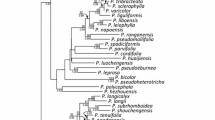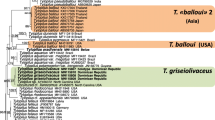Abstract
Extensive exploration of lichen diversity in the tiny and remote tropical island of Réunion (Mascarene Archipelago, Indian Ocean) yielded two new species in the hyperdiverse lichen family Parmeliaceae. Morphological, anatomical and chemical characters and molecular inferences from 3 loci (ITS, nuLSU and mtSSU) strongly support their assignment to Hypotrachyna (subgenus Longilobae) and Remototrachyna. Hypotrachyna producta is further assigned to H. subgenus Longilobae and is newly reported for Réunion as well as Remototrachyna costaricensis.






Similar content being viewed by others
References
Amo de Paz G, Cubas P, Divakar PK, Lumbsch HT, Crespo A (2011) Origin and diversification of major clades in parmelioid lichens (Parmeliaceae, Ascomycota) during the Paleogene inferred by Bayesian analysis. PLoS ONE 6(12):e28161
Aragón G, Belinchón R, Martínez I, Prieto M (2013) Estimating epiphytic lichen richness by single families in Mediterranean forests. For Ecol Manag 310:187–193
Arvidsson L (1990) Additions to the lichen flora of the Azores. Bibl Lichenol 38:13–27
Asahina Y (1951) Lichenes Japoniae novae vel minus cognitae (7). J Jap Bot 26:329–334
Baral HO (1992) Vital versus herbarium taxonomy: morphological differences between living and dead cells of Ascomycetes, and their taxonomic implications. Mycotaxon 44:333–390
Canêz LS (2005) A família Parmeliaceae na localidade de Fazenda da Estrela, município de Vacaria, Rio Grande do Sul, Brasil. Mastership dissertation, Instituto de Botânica, São Paulo. Available at : http://www.biodiversidade.pgibt.ibot.sp.gov.br/Web/teses/2005/pdf/Luciana_da_Silva_Canez_MS.pdf
Castresana J (2000) Selection of conserved blocks from multiple alignments for their use in phylogenetic analysis. Mol Biol Evol 17:540–552
Crespo A, Pérez-Ortega S (2009) Cryptic species and species pairs in lichens: a discussion on the relationship between molecular phylogenies and morphological characters. Anales Jard Bot Madrid 66(suppl 1):71–81
Crespo A, Kauff F, Divakar PK, Del-Prado R, Pérez-Ortega S, de Paz GA, Ferencova Z, Blanco O, Roca-Valiente B, Núñez-Zapata J, Cubas P, Argüello A, Elix JA, Esslinger TL, Hawksworth DL, Millanes AM, Molina MC, Wedin M, Ahti T, Aptroot A, Barreno E, Bungartz F, Calvelo S, Candan M, Cole MJ, Ertz D, Goffinet B, Lindblom L, Lücking R, Lutzoni F, Mattsson JE, Messuti MI, Miadlikowska J, Piercey-Normore MD, Rico VJ, Sipman H, Schmitt I, Spribille T, Thell A, Thor G, Upreti DK, Lumbsch HT (2010) Phylogenetic generic classification of parmelioid lichens (Parmeliaceae, Ascomycota) based on molecular, morphological and chemical evidence. Taxon 59:1735–1753
Cubero OF, Crespo A, Fatehi J, Bridge PD (1999) DNA extraction and PCR amplification method suitable for fresh, herbarium-stored, lichenized, and other fungi. Plant Syst Evol 216:243–249
Culberson CF, Hale ME Jr (1973) Chemical and morphological evolution in Parmelia sect. Hypotrachyna: product of ancient hybridization ? Brittonia 25:162–173
Del-Prado R, Cubas P, Lumbsch HT, Divakar PK, Blanco O, Amo de Paz G, Molina MC, Crespo A (2010) Genetic distances within and among species in monophyletic lineages of Parmeliaceae (Ascomycota) as a tool for taxon delimitation. Mol Phylogenet Evol 56:125–133
Divakar PK, Upreti DK (2005) Parmelioid lichens in India (A revisionary study). Bishen Singh Mahendra Pal Singh, Dehra Dun
Divakar PK, Lumbsch HT, Ferencova Z, Del-Prado R, Crespo A (2010) Remototrachyna, a newly recognized tropical lineage of lichens in the Hypotrachyna clade (Parmeliaceae, Ascomycota), originated in the Indian subcontinent. Am J Bot 97:579–590
Divakar PK, Crespo A, Núñez-Zapata J, Flakus A, Sipman HJM, Elix JA, Lumbsch HT (2013) A molecular perspective on generic concepts in the Hypotrachyna clade (Parmeliaceae, Ascomycota). Phytotaxa 132:21–38
Eliasaro S, Adler MT, Elix JA (1998) The species of Hypotrachyna (Parmeliaceae, lichenized Ascomycotina) from the Segundo Planalto in the state of Parana, Brazil. Mycotaxon 69:255–270
Elix JA (1994) Hypotrachyna. Flora Aust 55:49–59
Elix JA, Johnston J, Armstrong PM (1986) A revision of the lichen genus Xanthoparmelia in Australasia. Bull Br Mus Nat Hist Bot 15:163–362
Ferencova Z (2012) Estudio morphológico comparado de los caracteres generativos en relación con los linages monofiléticos de la familia Parmeliaceae (Lecanorales, Ascomycota). Ph D thesis, Universidad Complutense de Madrid. Available at: http://eprints.ucm.es/22628/1/T34425.pdf
Flakus A, Saavedra PR, Kukwa M (2012) A new species and new combinations and records of Hypotrachyna and Remototrachyna from Bolivia. Mycotaxon 119:157–166
Galloway DJ (1985) Flora of New Zealand lichens. Government Printer, Wellington
Gardes M, Bruns TD (1993) ITS primers with enhanced specificity for basidiomycetes—application to the identification of mycorrhizae and rusts. Mol Ecol 2:113–118
Hale ME Jr (1975) A revision of the lichen genus Hypotrachyna (Parmeliaceae) in tropical America. Smithson Contrib Bot 25:1–73
Harris RC (1993) Hypotrachyna costaricensis new to North America. Evansia 10:98
Hauck M, Javkhlan S (2009) Epiphytic lichen diversity and its dependence on bark chemistry in the northern Mongolian dark taiga. Flora 204:278–288
Jumaux G, Quetelard H, Roy D (2011) Atlas climatique de La Réunion. Météo-France, Sainte-Clotilde
Krog H, Swinscow TDV (1979) Parmelia subgenus Hypotrachyna in East Africa. Nor J Bot 26:11–43
Leavitt SD, Johnson LA, Goward T, St Clair LL (2011) Species delimitation in taxonomically difficult lichen-forming fungi: an example from morphologically and chemically diverse Xanthoparmelia (Parmeliaceae) in North America. Mol Phylogenet Evol 60:317–332
Leavitt SD, Esslinger TL, Divakar PK, Lumbsch HT (2012) Miocene divergence, phenotypically cryptic lineages, and contrasting distribution patterns in common lichen-forming fungi (Ascomycota: Parmeliaceae). Biol J Linn Soc 107:920–937
Leavitt SD, Esslinger TL, Spribille T, Divakar PK, Lumbsch HT (2013) Multilocus phylogeny of the lichen-forming fungal genus Melanohalea (Parmeliaceae, Ascomycota): Insights on diversity, distributions, and a comparison of species tree and concatenated topologies. Mol Phylogenet Evol 66:138–152
Louwhoff SHJJ, Elix JA (2002) Hypotrachyna (Parmeliaceae) and allied genera in Papua New Guinea. Bibl Lichenol 81:1–149
Lumbsch HT, Leavitt SD (2011) Goodbye morphology? A paradigm shift in the delimitation of species in lichenized fungi. Fungal Divers 50:59–72
Maddison DR, Maddison WP (2002) MacClade version 4.03PPC: analysis of phylogeny and character evolution. Sinauer Associates, Sunderland
Masson D (2005) Taxinomie, écologie et chorologie des espèces françaises des genres Hypotrachyna et Parmelinopsis (Ascomycota lichénisés, Parmeliaceae). Cryptogam Mycol 26:205–263
Masson D (2012) Hypotrachyna altorum sp. nov., a new lichen from the cloud forests of Réunion Island, Indian Ocean. Cryptogam Mycol 33:203–212
Miller MA, Pfeiffer W, Schwartz T (2010) Creating the CIPRES Science Gateway for inference of large phylogenetics trees. Proceedings of the Gateway Computing Environments Workshop (GCE), 14 nov. 2010. New Orleans, Louisiana, pp 1–8
Nash TH III, Sipman HJM, Elix JA (2002) Hypotrachyna. In: Nash TH III, Ryan BD, Gries C, Bungartz F (eds) Lichen flora of the Greater Sonoran Desert Region, vol I, Lichens unlimited. Arizona State University, Tempe, pp 238–251
Normann F, Weigelt P, Gehrig-Downie C, Gradstein SR, Sipman HJM, Obregon A, Bendix J (2010) Diversity and vertical distribution of epiphytic macrolichens in lowland rain forest and lowland cloud forest of French Guiana. Ecol Indic 10:1111–1118
Online Auction Color Chart Company (2004) The online auction color chart. Palo Alto, CA
Orange A, James PW, White FJ (2010) Microchemical methods for the identification of lichens. British Lichen Society, London
Patwardhan PG, Prabhu AV (1977) Some additions to the lichen flora of India. I. Genus Hypotrachyna (Vain.) Hale (Parmeliaceae). Curr Sci 46:176–178
Poelt J (1972) Die taxonomische Behandlung von Artenpaaren bei den Flechten. Bot Notiser 125:77–81
Rambaut A (2009) FigTree v1.2.3., available at http://tree.bio.ed.ac.uk/software/figtree/
Rambaut A, Suchard M, Drummond AJ (2013) Tracer v1.4, available at http://tree.bio.ed.ac.uk/software/tracer/
Rivas-Martínez S, Rivas-Sáenz S (2009) Worldwide bioclimatic classification system. Phytosociological Research Center, Madrid, Available at http://www.globalbioclimatics.org
Ronquist F, Huelsenbeck JP (2003) MRBAYES 3: Bayesian phylogenetic inference under mixed models. Bioinformatics 19:1572–1574
Saipunkaew W, Wolseley PA, Chimonides PJ, Boonpragob K (2007) Epiphytic macrolichens as indicators of environmental alteration in northern Thailand. Environ Pollut 146:366–374
Sipman HJM (1993) Lichens from Mount Kinabalu. Trop Bryol 8:281–314
Sipman HJM (2002) The significance of the Northern Andes for lichens. Bot Rev 68:88–99
Sipman HJM, Elix JA, Nash TH III (2009) Hypotrachyna (Parmeliaceae, Lichenized Fungi). Flora Neotropica Monogr 104:1–176
Stamatakis A (2006) RAxML-VI-HPC: maximum likelihood-based phylogenetic analyses with thousands of taxa and mixed models. Bioinformatics 22:2688–2690
Stamatakis A, Hoover P, Rougemont J (2008) A rapid bootstrap algorithm for the RAxML Web servers. Syst Biol 57:758–771
Strasberg D, Rouget M, Richardson DM, Baret S, Dupont J, Cowling RM (2005) An assessment of habitat diversity and transformation on La Réunion Island (Mascarene Islands, Indian Ocean) as a basis for identifying broad-scale conservation priorities. Biodivers Conserv 14:3015–3032
Thell A, Crespo A, Divakar PK, Kärnefelt I, Leavitt SD, Lumbsch HT, Seaward MRD (2012) A review of the lichen family Parmeliaceae—history, phylogeny and current taxonomy. Nord J Bot 30:641–664
van den Boom PPG, Brand M, Ertz D, Kalb K, Magain N, Masson D, Schiefelbein U, Sipman HJM, Sérusiaux E (2011) Discovering the lichen diversity of a remote tropical island: working list of species collected on Reunion (Mascarene archipelago, Indian Ocean). Herzogia 24:325–349
White TJ, Bruns T, Lee S, Taylor JW (1990) Amplification and direct sequencing of fungal ribosomal RNA genes for phylogenetics. In: Innis MA, Gelfand DH, Sninsky JJ, White TJ (eds) PCR protocols: a guide to methods and applications. Academic, San Diego, pp 315–322
Yánez-Ayabaca A (2009) Os gêneros Hypotrachyna e Everniastrum (Parmeliaceae, Ascomycota Liquenizados) nas províncias de Carchi e Imbabura na região Andina do Equador. Mastership dissertation, Universidade Federal do Paraná. Available at: http://dspace.c3sl.ufpr.br:8080/dspace/bitstream/handle/1884/17926/Dissertacao.Alba%20Yanez-Ayabaca.pdf?sequence=1
Zoller S, Scheidegger C, Sperisen C (1999) PCR primers for the amplification of mitochondrial small subunit ribosomal DNA of lichen-forming ascomycetes. Lichenologist 31:511–516
Acknowledgements
Field studies in Réunion were made possible with the help and advice from the Parc National de La Réunion, especially through the courtesy of Mr. B. Lequette. Field collections were made under collecting permits provided by the National Park authority. One collection of Hypotrachyna penduliloba was made during a field trip to Réunion with N. Magain; his great companionship is acknowledged here. Harrie J. M. Sipman is thanked for arranging the loan of comparative material from B and for providing nomenclatural advice. Both referees contributed to the finalization of the manuscript as their notes and suggestions were very helpful: we thank them very warmly. P.K.D. thanks the Ministerio de Ciencia e Innovación, Spain for financial support (CGL2010-21646/BOS).
Author information
Authors and Affiliations
Corresponding author
Rights and permissions
About this article
Cite this article
Masson, D., Divakar, P.K. & Sérusiaux, E. Hypotrachyna penduliloba and Remototrachyna pandani, two new species in the hyperdiverse lichen family Parmeliaceae from Réunion in the Mascarene Archipelago. Mycol Progress 14, 22 (2015). https://doi.org/10.1007/s11557-015-1039-x
Received:
Revised:
Accepted:
Published:
DOI: https://doi.org/10.1007/s11557-015-1039-x




